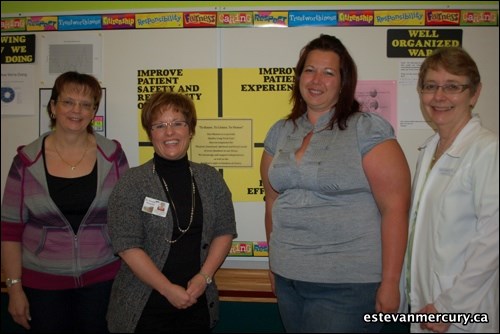They are placing their own brand on the Release Time to Care mandate in the extended care wing at St. Joseph's Hospital.
"We're not dealing with patients on our wing; we have residents here, so we're introducing the program with that in mind," said Christina Stephany, one of four team leaders for that area of the hospital where the third phase of the Release Time to Care model has now rolled out for the benefit of staff and clients.
Stephany was joined by Debbie Skogberg, Cory Ouellette and Kathy Ogle in forming the current leadership team that travelled to Saskatoon to receive further training in the Release Time to Care program which is an arm of an efficiency program entitled LEAN that was incorporated as a Japanese business model and later adapted to apply to a number of other industrial and service industries.
"Change is always difficult," said Ogle, "but we've decided to do it. It's a staff driven program. On this wing of the hospital, I'd say we have about 30 employees who will be involved," she said.
Kristine Mitchell, who has served as facilitator for the exercise, said that the maternity section plus Unit A (primary care) and the emergency ward were introduced to the program earlier and have implemented time and energy saving practices.
With the efficiency comes further comfort and safety for the residents, the team said. In fact a few residents will be invited to join the team and provide suggestions to increase efficiency in this particular area of the facility.
"We're excited about getting this going," said Stephany. "We'll identify areas of improvement; where we can save steps, for example, how to protect residents from falls or discomfort, preventing infections with routine hygiene audits, getting better knowledge about particular diseases. There are several things we can do to speed certain things up so we can spend more time with the residents."
The team members said delivering and administering medications will be one immediate area to look at. They'll also be assessing the distances and time they spend walking during the course of a working day or shift. They will have a computer tracking system assisting them for long range planning.
Because the program has been operative in other sectors of the hospital, the extended care employees know they won't have to re-invent the wheel on a few fronts. They'll have an efficiency model already in place that they can follow.
Mitchell said by implementing some of the models introduced on Unit A or in maternity, the extended care employees will be able to adopt and adapt certain procedures and make them their own.
"They will be paying particular attention to patient safety, reliability of service and equipment and improving staff well-being while improving resident experiences," Mitchell said.
The four-member team will return to Saskatoon for more information and to report what they have learned to a central body so that any new wrinkles or suggestions can be shared province-wide.
"Even things like being able to engage more residents for longer periods of time during their meals, is a good goal to have," said Stephany.
That means the dietary and recreation employees have a say in the program. In fact the team on the extended care wing will be meeting every Wednesday at 1 p.m. to discuss where they have gone, where they are going and how they can get there in a more efficient manner.
The extended care wing at St. Joseph's Hospital includes 38 residents plus four respite beds used for transitional care or other purposes.




